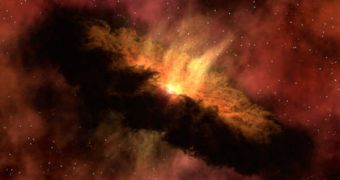Our solar system was formed approximately six billion years ago, from what new pieces of evidence suggest was a well-blended “soup,” made up from the appropriate amounts of gas and dust, cobbled together by the forces of countless exploding stars around. The new theory came from researchers studying meteorites and asteroids, which are some of the oldest formations in the solar system to date. Some precede even the oldest planets, and were formed immediately after the Sun, and before the star started spinning matter around it, thus creating the planets and the asteroid belts.
A Danish research team from the Natural History Museum, led by expert Martin Bizzarro, believe they may have found a clue as to what the solar nebula might have looked like before the actual star was born, and also how many stars were involved in the process. The way they discovered the recent hints was by analyzing traces of titanium found on meteorites from the Moon and Mars, as well as from some that fell on Earth millions of billions of years ago.
The reason why titanium is fit for such studies is the fact that it can produce some extremely stable isotopes, which are forms of the atom that have varying numbers of neutrons. The thing about these isotopes is that they can be used comparatively, as in the results obtained from “reading” the information of one such atom can be cross-referenced with data obtained from another type. The Danish team made good use of these traits, and discovered that two isotopes, namely titanium-50 and titanium-46, were found in similar proportions in all of the studied objects.
According to Bizzaro, the cores of massive collapsing stars are responsible for the creation of the titanium-46 isotopes, which have 22 protons and 24 neutrons, while titanium-50 is usually created by dwarf stars after they “cannibalize” companion stars. He also told NewScientist that two different types of explosions created the two kinds of isotopes, and that the fact that they could be found in similar concentrations and proportions in all meteorite samples opened a window into the tumultuous past of the early solar system, just before and shortly after the Sun had been created.
“People thought that the isotope anomalies typically reflected that the cloud from which the solar system formed was not very well homogenized,” he said. But the new find seems to prove otherwise. His theory is, thus, just one possible explanation for the titanium dilemma. Others maintain that a gas cloud containing both varieties of the chemical may have impacted the early solar system. “Then you could have wild inhomogeneity in how the dust was distributed in the solar disc, while preserving the association between the two isotopes of titanium,” Arizona State University in Tempe expert Jeff Hester explained.

 14 DAY TRIAL //
14 DAY TRIAL //